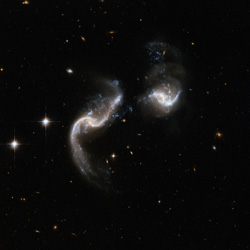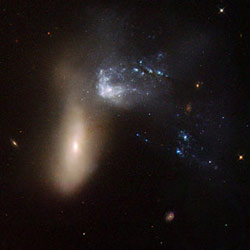What happens when a smallish galaxy plows right through the center of a bigger one?
This:
Holy Haleakala. That’s Arp 148, and it’s magnificent. That elongated galaxy was probably not quite so stretchy before it hit, but the gravity of the other galaxy drew it out. In turn, its own gravity drew in stars and gas from the bigger galaxy, which then expanded as a ring as the smaller galaxy plunged on. It almost looks like a freeze-frame image of a bullet shattering a drum head.
If you like that, you’ll love this: Hubble has released 59 such images of galaxy collisions today (the US version of the release is here), celebrating Hubble’s 18th anniversary in space. It launched on April 24, 1990.
 The galaxy pictures are stunning. The one on the left is Arp 256, two spiral galaxies interacting as they pass each other for the first time. Long tendrils are being drawn from both galaxies, and the blue regions indicate epic bursts of star formation (young, massive stars are blue and extremely luminous). Someday the Milky Way and Andromeda galaxies will look very much like this… a billion years from now, when they pass each other. I’d write more here, but golly, I have a book coming out in October with lots more details. :-)
The galaxy pictures are stunning. The one on the left is Arp 256, two spiral galaxies interacting as they pass each other for the first time. Long tendrils are being drawn from both galaxies, and the blue regions indicate epic bursts of star formation (young, massive stars are blue and extremely luminous). Someday the Milky Way and Andromeda galaxies will look very much like this… a billion years from now, when they pass each other. I’d write more here, but golly, I have a book coming out in October with lots more details. :-)
 This one is even weirder: it’s a red elliptical galaxy and a bluish spiral interacting. The blue galaxy looks to be small to my eye; it’s getting totally disrupted by the elliptical. There’s some indications of dust getting blown every which-way in the elliptical too. This will be a very interesting system in about another 500 million years or so.
This one is even weirder: it’s a red elliptical galaxy and a bluish spiral interacting. The blue galaxy looks to be small to my eye; it’s getting totally disrupted by the elliptical. There’s some indications of dust getting blown every which-way in the elliptical too. This will be a very interesting system in about another 500 million years or so.
I’ll leave you with one more: NGC 6050.
Two magnificent spiral galaxies, each about the same size, slide toward one another and are just now beginning their slow dance. I can almost imagine them spinning like buzz saws into each other, tearing both to shreds (in fact, they look a whole lot like the animation of colliding galaxies used in my short astronomy video on Hulu – and yes, we’ll be posting that on internationally-accessible servers soon). The two spirals will no doubt merge completely into an elliptical… unless they’re moving too quickly. They are both part of the Hercules Cluster of galaxies, 650 million light years away (the press release says 450 million, but the 2MASS catalog says 650). Hercules has over 100 galaxies in it and is therefore pretty massive; all that mass means a lot of gravity, and that in turn means the component galaxies are screaming along at high velocity. It’s possible these two beauties will continue on their way, passing through each other, distorted, beaten, but surviving.
I wonder how that story will end; lover’s embrace or ships passing (literally) in the night? With images like these, astronomers will learn a lot more about how galaxies behave when they collide, and that will point the way to better, more detailed observations. Eventually we’ll know how the story goes, from start to finish.
Our own future is wrapped up in these images, writ large across the sky. As usual in astronomy, and in science as a whole, by looking outwards we learn more about ourselves.
Happy anniversary, Hubble.